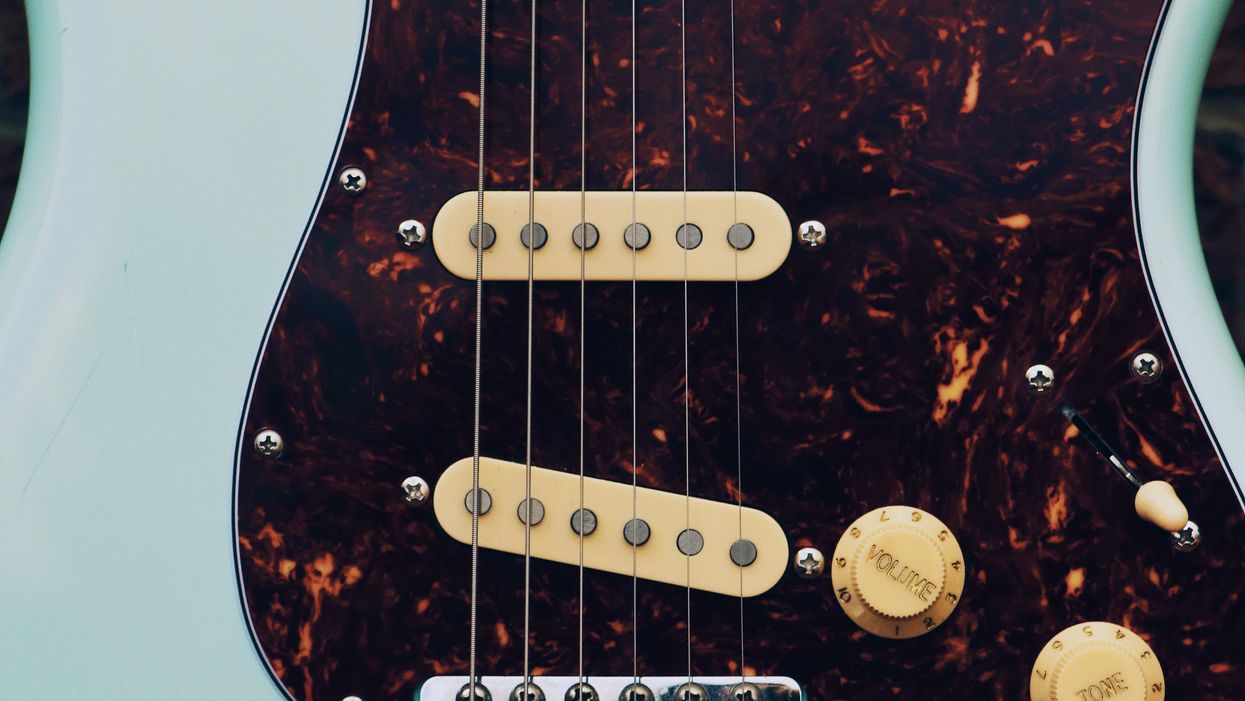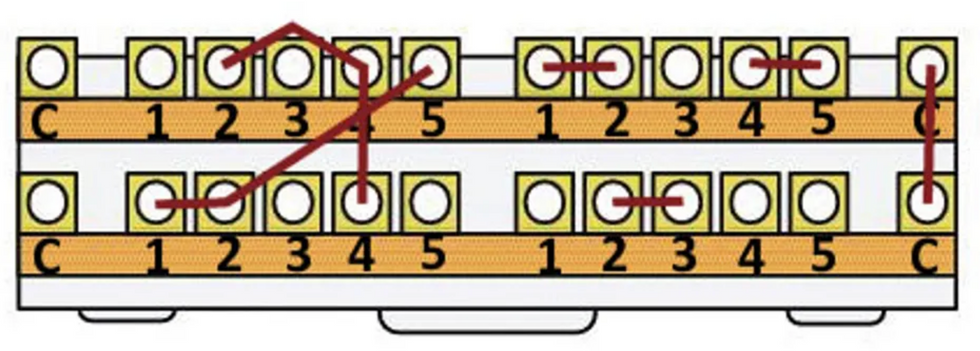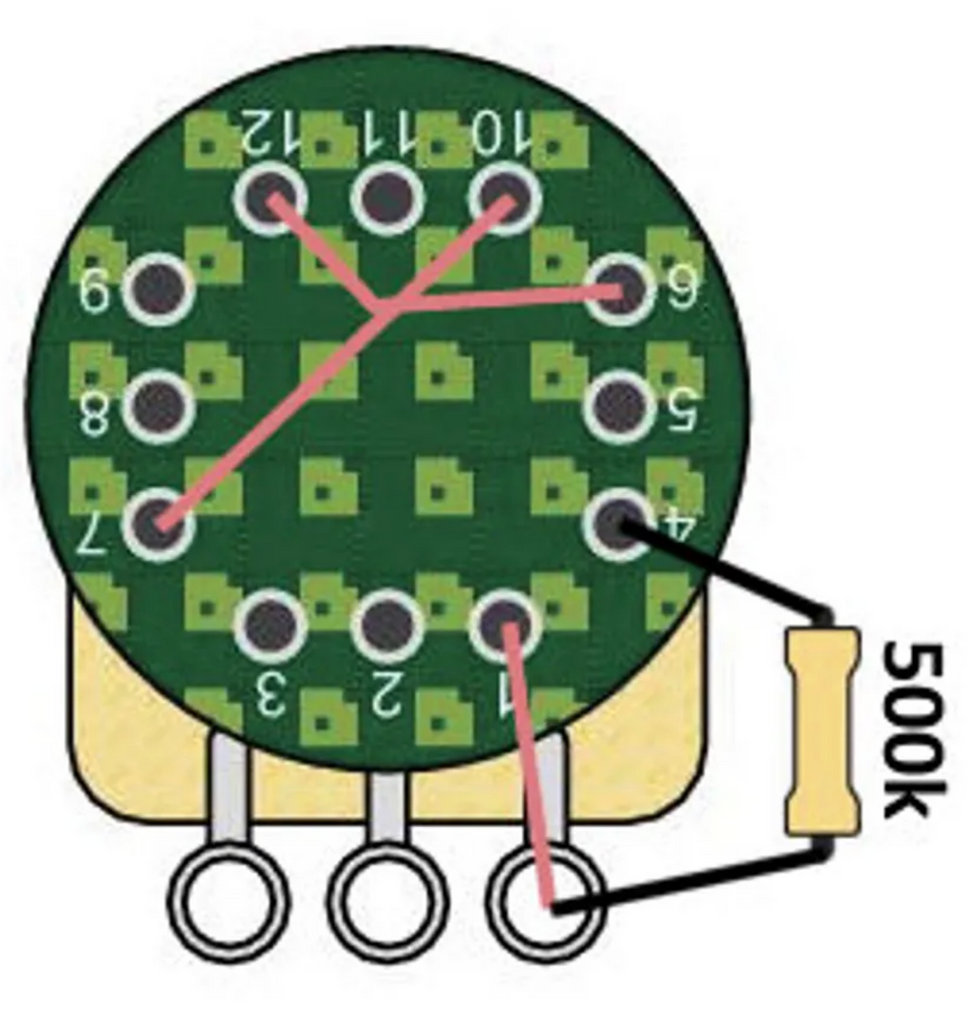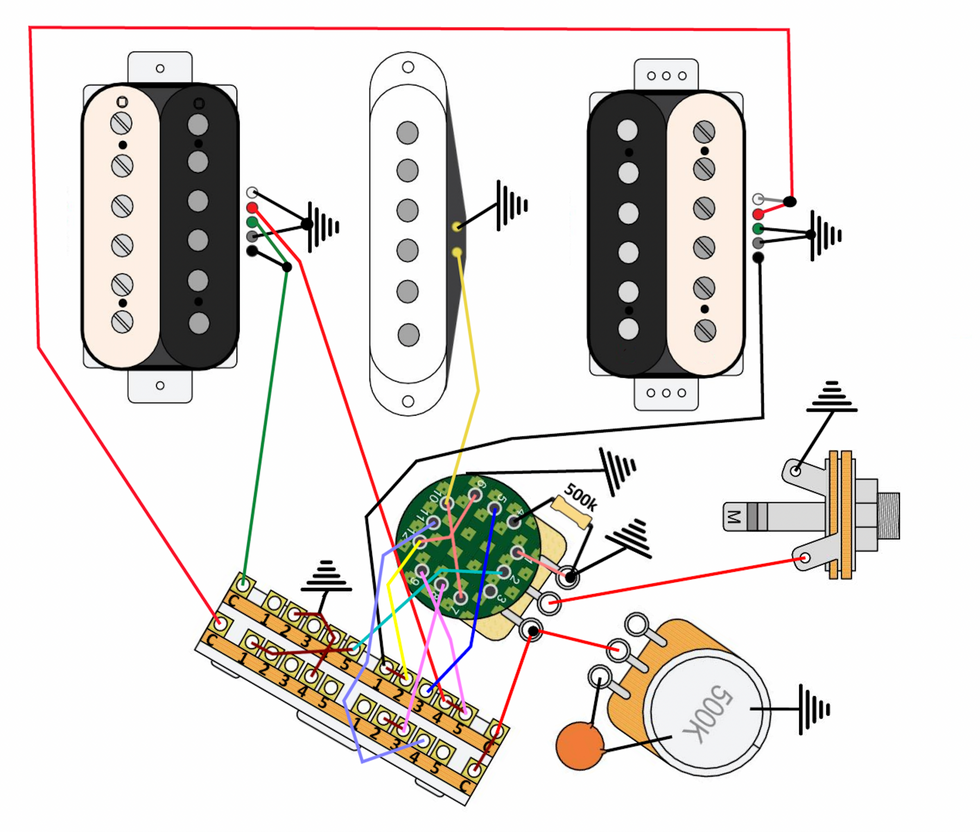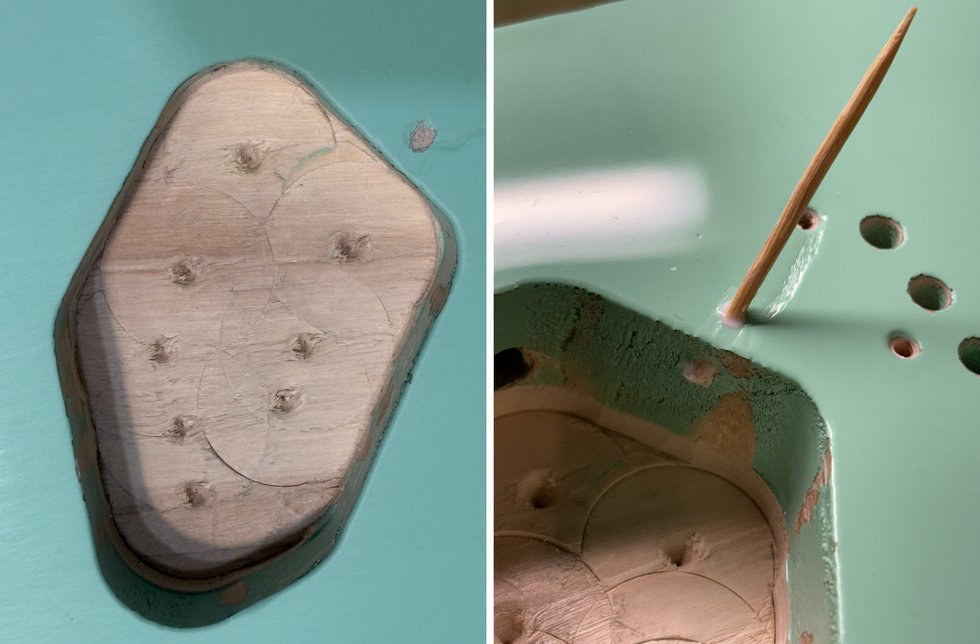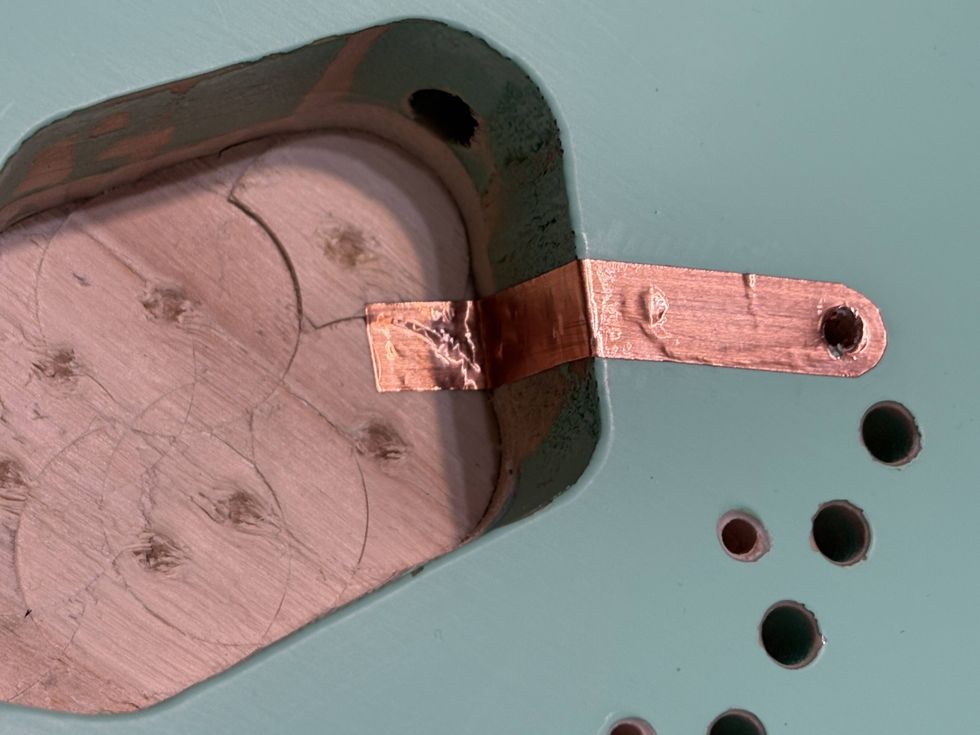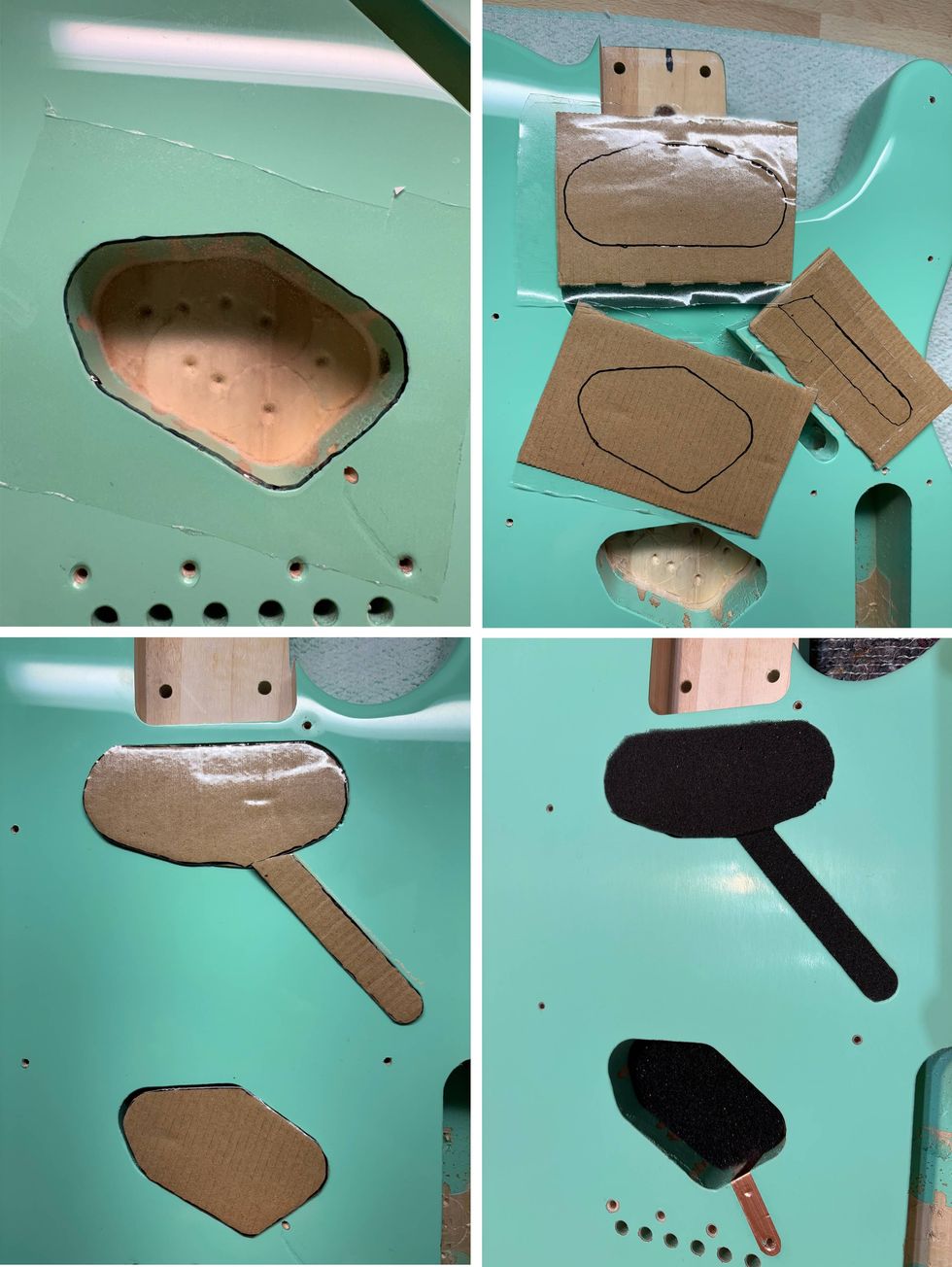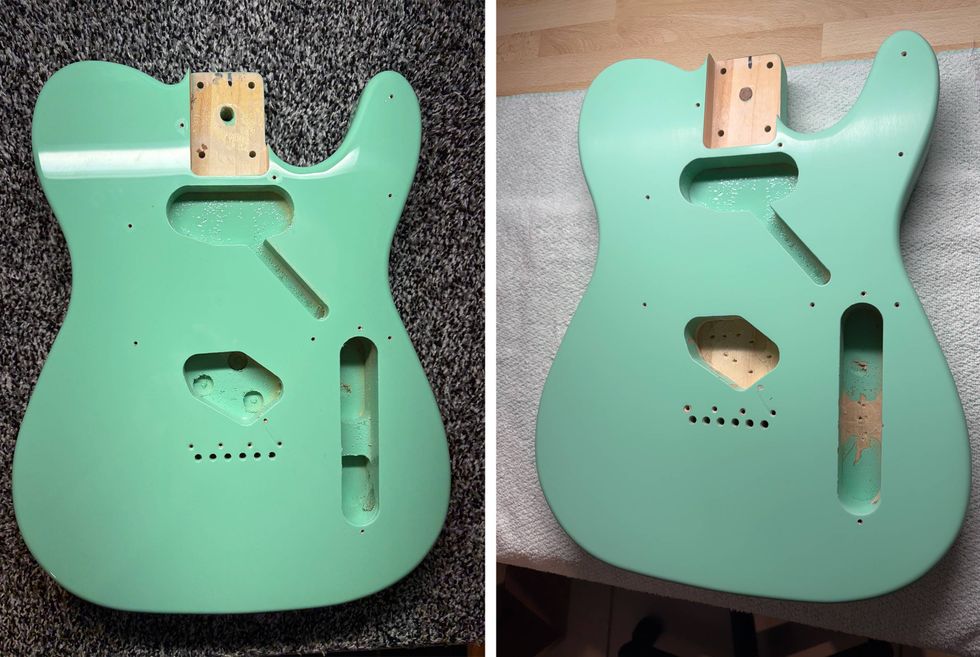Exactly 10 years ago, I wrote my first column for the publication that evolved into Premier Guitar, and as you can imagine, this is a landmark for me. To celebrate this decennial anniversary, I've cooked up something special. Fair warning: This is a complex mod, so it may not be for everyone. But even though the wiring resembles a circuit from the Apollo 12 mission, it's worth the work if you dream of having a vast sonic palette at your fingertips. The goal of this wiring is to create two independent switching stages: a standard Stratocaster setup mated with a typical PRS scheme. This “Strat-PRS crossover" will give you the best of both worlds in one guitar.
Overview and considerations.
For this project, you need a guitar with three pickups—neck and bridge humbuckers, plus a middle single-coil—wired to a special 5-way switch and master volume and master tone controls.
To get the required HSH configuration, you can take an existing dual-humbucker guitar and add a middle single-coil or replace a Strat's neck and bridge single-coils with humbuckers. For most guitars, this will necessitate body routing (a job for a pro) as well as a new pickguard.
A few other things to bear in mind: While it's possible to use single-coil-sized humbuckers, you'll get the best results using standard humbuckers with a middle single-coil. In particular, it's the PRS tones that benefit from this pickup mix.
Although the middle pickup can be any standard single-coil of your choice, both humbuckers must have 4-conductor wiring. If you have traditional 2-conductor humbuckers, you can either convert them to 4-conductor wiring or simply replace them with modern 4-conductor types. I suggest considering the latter, because converting a 2-wire humbucker to a 4-wire design entails removing the cover, and this exposes the extremely delicate coil wires. In this state, it's easy to damage the pickup. Unless you're comfortable with such an operation, take the pickups to your local tech or send them to a pickup manufacturer and ask them to do the conversion for you. Again, the safest option is to use stock 4-wire humbuckers, which are readily available from dozens of companies.
Also, when wiring two pickups together and splitting a humbucker, it's easy to get lost in all kinds of out-of-phase issues when you mix pickups from different makers. To avoid inadvertent phase problems, I highly recommend using all three pickups from the same manufacturer. This will ensure that both the polarity of the magnets and polarity of the individual coils—and this is especially critical for the humbuckers—are correct in relation to each other. (In future columns I'll go into this topic in greater detail and show you how to avoid any phase troubles right from the get-go.) If you intend to combine pickups from different companies, contact the manufacturers' service departments and explain what you want to do so they can guide you through the pickup selection process.
The nitty-gritty. For this mod, you'll need a 5-way switch with four, instead of the standard two, independent switching stages. The open-framed version of this switch is available from Fender as a 5-way Super Switch, but there are also PCB-based versions of this switch. To find out more about these switches, read "Introducing Fender's 5-Way Super Switch" and "Exploring Fender's 5-Way Super Switch."
Even though the wiring resembles a circuit from the Apollo 12 mission, it's worth the work if you dream of having a vast sonic palette at your fingertips.
This project also requires an additional switch to toggle between standard Strat and PRS modes. You can either add a 4PDT mini-toggle switch or replace one of the pots with a Fender S-1 push/push switching pot. I opted for the S-1 to keep the control layout as clean as possible, but if you want to install an additional switch instead, you can convert the S-1's switching matrix to your 4PDT switch.
Another item you'll need for this project is a 500k-ohm resistor. Any type and wattage will do; I use a 1/4-watt metal film resistor because it's small and easy to work with.
Both the master volume and tone pots are 500k, a value that makes sense for the PRS mode. For the Strat mode, we have a neat little trick I'll show you in a moment. As for the tone cap, a standard 0.022 µF value will work fine. If you want a little less capacitance, try a 0.015 µF or 0.01 µF value. Either will work great for the Strat mode. If you want, you can also incorporate the typical PRS treble bleed network between the volume's input and output to keep the high-end alive when rolling back the volume. This will work for the Strat mode as well, but not perfectly—give it a try and see what you think. The official PRS method is a 180 pF "cap only" wiring.
The following chart details the 10 pickup selections in our crossover wiring scheme.
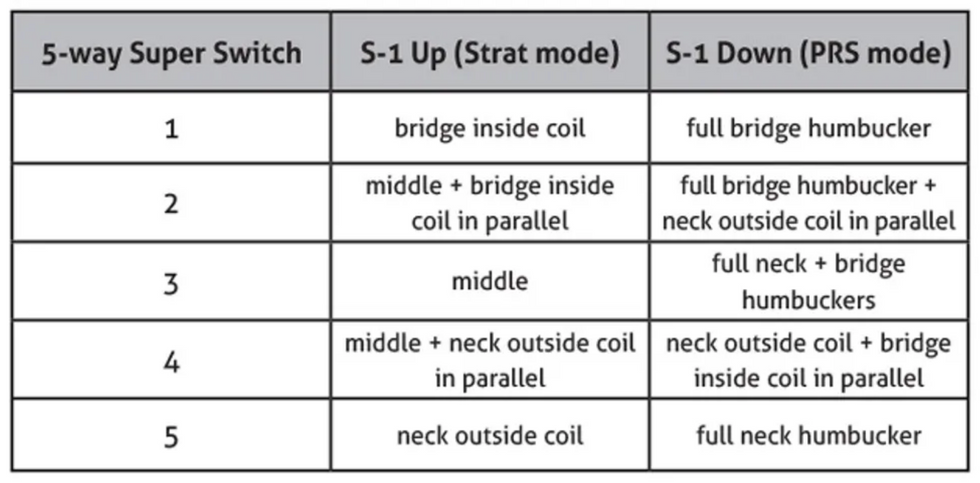
The Strat mode yields five classic single-coil tones—bridge, middle, and neck pickups solo, plus a pair of dual-pickup settings. For the latter, the humbuckers are split and the active coil is wired in parallel to the middle single-coil to achieve the Strat's signature cluck in positions 2 and 4. Depending on the humbuckers, this can work quite well.
Pushing the S-1 down gives you the switching matrix of a modern PRS equipped with two humbuckers. Position 4 sounds similar to a Telecaster's middle position, with bridge and neck single-coils in parallel, and when you add that to the available Strat and full humbucker settings, you have a lot of tonal possibilities.
Hookup tips.
Because there are so many wires to connect, I recommend approaching this in two stages. Start by soldering all the jumper wires on the 5-way Super Switch (Fig. 1) and the S-1 pot (Fig. 2). It's much easier to solder these wires before mounting the components in the guitar.
Notice the additional 500k resistor on the S-1 switch, soldered between the switch and the lug that will ultimately connect to ground. This is a cool little gimmick to get a more classic Strat tone. Here's the lowdown: A standard Strat has three 250k pots, yet here we have two 500k pots—a configuration that gives the middle single-coil more highs than we're used to hearing on a Strat. By adding this 500k resistor in parallel, the middle single-coil will sound like it's in a 250k environment when the S-1 is in Strat mode.
Fig. 3 is the full schematic. I used Seymour Duncan's color code—a standard for such drawings. If you're using pickups from a different manufacturer, simply convert the color code of the wires, following the manufacturer's instructions. To keep the schematic as clean as possible, whenever multiple wires lead to the same spot, I combine them in the drawing. In such a complex wiring, it's very easy to mix something up, so be patient and work methodically. Go one step at a time and double-check each connection.
Next time, we'll begin investigating pickup parameters to learn how to interpret them and what they can tell us about a given unit's sound. Until then ... keep on modding!
[Updated 9/27/21]


